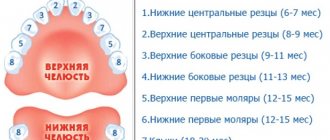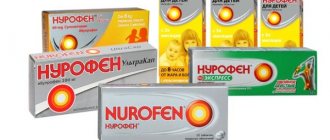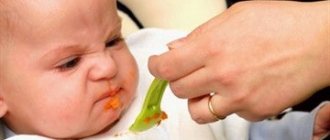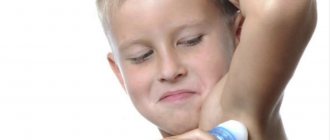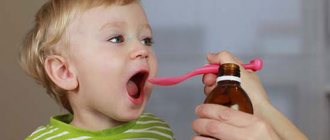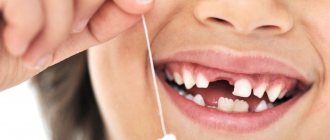The baby is soon 6 months old, drooling more profusely, whims are happening more and more often, and parents are advised to be patient, prepare for sleepless nights and stock up on teethers, pain-relieving gels, antipyretics, sedative herbs, etc. The first tooth will appear soon!
In some children, the appearance of teeth causes discomfort or even pain, their general condition worsens, their temperature rises, and their appetite disappears. But many parents are not even aware of the teething problem: the child does not show any concern. It's all about the individual pain threshold.
It is possible and necessary to help especially sensitive children; for this, there are a number of special teething products. We choose the best and most effective.
Means to ease teething in babies
Gels are extremely popular among mothers. Depending on their composition, they are divided into 3 groups, each of which has its own advantages and disadvantages. Therefore, when choosing any medication for a child, consult a specialist: a pediatrician or a pediatric dentist.
Painkillers
Their action is ensured by the anesthetic included in the composition, most often it is lidocaine hydrochloride, which creates an almost instantaneous (pain will go away after 2-3 minutes) cooling and analgesic effect.
Anti-inflammatory, antiseptic or homeopathic components are also added to many such gels and ointments, thereby achieving a combined effect. However, these tools still have their drawbacks:
- Although the effect occurs quickly, it does not last long, from 10 to 20 minutes: due to profuse salivation in children, the gel is simply washed off and swallowed.
- The drug can be applied no more than 3-5 times a day.
- Lidocaine causes numbness and difficulty swallowing, so it is best to use the ointment after the child has eaten.
- Individual intolerance to lidocaine or other components of the drug.
Homeopathic medicines
The same traditional medicine, but in modern packaging. Extracts of various plants in the gel have an analgesic and anti-inflammatory effect.
The only contraindication can be an allergy to natural components. The effectiveness is lower than traditional pain relievers, but it is a good solution if you are looking for a lidocaine-free solution that can be applied an unlimited number of times per day.
Anti-inflammatory and antiseptic gels
They relieve pain not with lidocaine, but with substances such as choline salicylate and cetalkonium chloride. Therefore, they do not cause numbness, and the effect lasts for several hours.
The only negative is that there may be a short-term burning sensation after application, but it goes away on its own.
Ways to understand that your baby is teething
How to understand that teeth are being cut? According to pediatricians, the lower incisor should come out first, then the second paired one. Next comes the time for the upper central incisors and the lateral incisors above and below. All of them are expected to grow up to a year. And from the age of one and a half years, the first molars begin to appear.
The child is teething, what other symptoms exist besides the sign described above? Here's a short list:
We suggest you read: In the mouth in the throat on the tonsils and tonsils, white pus lumps with an unpleasant odor: what are they?
- Inflamed, swollen gums.
- Developing the habit of putting everything in your mouth.
- Loss of apatite.
- Restless sleep.
- Crying at night.
Teething also affects the baby's behavior - he begins to be capricious more often and ask to be held, and quickly gets excited. There is also intolerance to harsh sounds and bright light. Mood swings are common.
Teething may be accompanied by:
- high temperature;
- frequent regurgitation;
- constipation or diarrhea;
- rashes on the cheeks;
- cough and runny nose.
Review of popular drugs for teething
| Name | How it works | price, rub. | Rating |
| Cooling and pain-relieving gels | |||
| Kalgel |
| 279 | 3 |
| Dentinox |
| 310 | 1 |
| Kamistad |
| 180 | 5 |
| Homeopathic remedies | |||
| Baby Doctor First teeth |
| 337 | 2 |
| Pansoral First teeth |
| 327 | 6 |
| Anti-inflammatory gel | |||
| Holisal |
| 320 | 4 |
Baby teeth
Before you find out how to help your child when their first teeth are cutting, it is worth getting some information about these formations. The first rudiments appear at about ten weeks. During this period, the baby is still in the womb. The harbingers of permanent teeth form somewhat later (approximately in the middle of pregnancy).
We suggest you read Inflammation of the lips in a child - cheilitis
Most babies are born with bare gums. However, medicine knows of cases where a child was born with one or even two front incisors. In most cases, babies develop teeth at the age of 6-8 months. In this case, the acceptable range is from three months to a year. All cases that deviate greatly from the norm require medical intervention.
Folk remedies for teething in children
Every caring grandmother will give you a whole list of similar recipes:
- infusion of burdock and chickweed root;
- boiled clove and almond oils;
- mumiyo solution;
- decoction of sage and plantain;
- propolis and honey;
- valerian.
Traditional medicine advises all this to be lubricated on the gums or, with the exception of oils, taken orally.
To relieve pain, grandmothers can offer their grandson to chew strawberry or chicory root, chilled raw carrots, an apple or cucumber.
But all such recipes should be treated with great care.
On the one hand, this is a centuries-old experience, but on the other, honey, propolis and various oils are fraught with allergies, and scratching the gums with raw vegetables and fruits is not very safe, since a child may choke on an accidentally bitten off piece.
Chamomile has a mild analgesic, anti-inflammatory and calming effect, but the key word here is “mild”, so this infusion will only help with minor pain.

Thanks to the grandmothers for their help, but the modern mother has more effective and safe means in her arsenal.
Diarrhea during teething
The changes in the children's stool were insignificant, and if diarrhea appeared or strange mucus in the diaper, then I diluted a little Loklo (1 teaspoon per 100 ml of water) + gave Colloidal silver (half a pipette 2-3 times a day) + Bifidophilus flora force (1 capsule per day). If the diarrhea is from the teeth, then it will go away on its own, but I was afraid that suddenly an infection or some kind of bacteria had entered the intestines, because the child licked everything around and the diarrhea could appear not from the teeth, but from something eaten or an infection, but to determine immediately causing diarrhea is very difficult... We always have the listed products in our home medicine cabinet, they are natural and safe for children, so I gave the listed products simply for prevention. As a rule, the stool returned to normal within 1-2 days.
This is how simple and effective teething help can be provided to your child! Let your children grow up healthy and delight you with their smiles, like mine =)!
I am always happy to share my experience and help young mothers with babies just like me! When you need my help, contact me!
How to help without drugs
Moms advise:
- When teeth are being cut, the baby, in order to relieve pain and itching, puts everything he can into his mouth. Offer him a cooling teether - a special silicone or rubber ring filled with water. Place it in the refrigerator for 20-30 minutes before use. Bright and textured, it will distract the baby from pain and relieve swelling of the gums.
- Another universal method is massage. A clean mother’s finger presses lightly on the gums, thereby reducing pain. A silicone toothbrush placed on your finger will also work.
- And, of course, mother’s love. Parental warmth, attention and care will definitely help the baby cope with pain.
Find out in our article what order the first teeth are cut in!
mydentist.ru
How does teething occur in children?
Before the tooth hatches into the light, it passes first through the bone tissue and then through the mucous membrane of the gums. The process of teething causes inconvenience to the baby, because... is painful and leads to inflammation of the gums. At the site where the tooth grows, a huge amount of biologically active substances begins to be released, resulting in a sharp decrease in immunity.
The combination of these factors is the main reason why a child’s temperature rises during teething. The baby experiences increased salivation (salivation), which serves as a natural reaction to protect the body from the inflammatory process. Saliva is a kind of bactericidal agent that reduces the spread of inflammation of adjacent tissues.
Symptoms
Typical symptoms of teething in babies are:
- swollen, inflamed gums;
- profuse drooling;
- itching of the gums (which causes the baby to put various objects in his mouth);
- possible increase in temperature;
- redness of the cheeks.
When teething, a child experiences:
- changeable mood;
- anxiety;
- moodiness (especially during night sleep);
- decreased appetite;
- frequent breastfeeding (when breastfeeding a baby).
Many mothers are concerned about the question: how long does the temperature last during teething? Since this is a reaction of the body’s defense to the ongoing process, it is the norm. As a rule, body temperature is 37-38 degrees, lasts 1-3 days, then subsides. If the thermometer starts to rise, call an ambulance or your pediatrician.
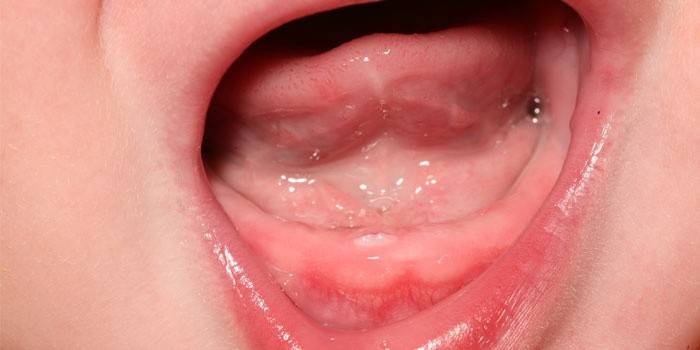
Folk remedies and useful tips during teething
1) When teething, children were prepared with soothing herbal teas, which simultaneously relieved pain and itching in the gums. To do this, they took medicinal herbs in equal parts: lemon balm, lavender flowers, chamomile, primrose and catnip. Then 1 tablespoon of the mixture was poured into a glass of boiling water and left for 30 minutes. They filtered and gave this tea to the children instead of water. This herbal drink is also useful for breastfeeding mothers. The child is not capricious and does not cry.
2) They used a recipe consisting of herbs: burdock root, chamomile and chickweed. An infusion was made from this collection and smeared on the baby’s gums.
3) Relieves inflammation of the gums and relieves pain with clove oil. However, it should be diluted with boiled almond oil in a 1:1 ratio. (Any other vegetable oil will work for this recipe.) The product is applied to a sterile bandage and lubricated the baby’s gums.
4) Chamomile tea relieves pain and calms the child. A concentrated decoction of this medicinal plant is used to lubricate inflamed gums.
5) Valerian is a good pain reliever for gums, relieves itching and soothes the baby. The extract of this plant is diluted with water and applied to the child’s gums.
6) During this period, our grandmothers gave small children chicory or strawberry roots to chew on. They relieve itching and slightly reduce pain.
7) The peoples of Altai lubricated the gums of children with mumiyo solution. This is a powerful natural pain reliever.
8) Our grandmothers widely used propolis when teething in children. To do this, an aqueous solution with this substance was prepared. The gums were lubricated with this product and the child was given a drink.
9) Simply lubricating the gums with honey relieves pain and distracts the child. It should be taken into account that you are not allergic to it.
10) You can give your baby (until the first tooth appears) raw carrots, cucumber, apple, pear. It is recommended to cool vegetables and fruits well.
11) For severe pain, it is recommended to give children a frozen banana. It relieves pain and cools the gums.
12) You can lubricate your gums with a decoction of sage and plantain. These are excellent anesthetics. Sage is given to the child to drink. It strengthens the gums. When bathing, these herbs are added to the bath, they soothe him and provide restful sleep.
13) People have long noticed the pain-relieving properties of amber during teething in children. Mothers wore beads made of this natural stone under their child’s shirt. However, remember that such jewelry should only be worn on a ribbon and only during the day.
14) Elderly people say that the best pain reliever for their children’s teething was “mother’s finger.” The child not only calmed down, but also chewed the tasty “toy” with pleasure. Do not forget to wash your hands thoroughly before doing this or wipe them with a disinfectant.
15) During teething, it is recommended to place a small pillow under the baby’s head at night, the blood will move away from the gums and they will bother you less.
16) A good anesthetic effect is obtained by massaging the gums with a finger wrapped in a bandage and soaked in a soda solution. This can be done simply with sterile hands, but very carefully.
17) During the period of teething, bread products such as hard bagel (drying), crackers, shortbread, cookies are good to distract the child from pain and relieve itching. They should be changed depending on the softening so that the baby does not choke.
18) Many people are saved by a pacifier during this period. The child calms down with her.
Pharmacies sell special rings and toys with a cooling effect for teeth. They distract the child from pain and massage the gums. It should be remembered that such toys should only be of high quality. Rings with fillers must be made of durable material.
Our ancestors gave children a wet, chilled linen napkin. Today, special handkerchiefs designed for children are sold; these products can be chewed.
19) You can give your child a new, well-washed, soft toothbrush. It will act as a massager and relieve itching.
Of course, the most universal remedy during this period will be double parental affection, attention and care for the baby. Don’t be afraid to spoil your child, carry him in your arms more and hold him close to you. He will feel protected and become calmer.
narodnymisredstvami.ru
Safe folk remedies for teething in babies
You can help your baby teething using home remedies. Do not rush to give your baby painkillers from the pharmacy; along with the benefits, they can cause harm. What to do if a child is cutting teeth and crying bitterly:
- relieve pain by gently rubbing the gums with a weak solution of chamomile flower decoction: brew tea from ½ tsp. plants in 200 ml of water, cool, filter. Dip soft gauze into the solution, gently moisten swollen cheeks and gums;
- anti-inflammatory drugs: sage, valerian root are used in the form of a weak infusion. To do this, place one of the plants (or powder) in boiling water for 5 minutes, take it out, cool the drink, and apply it to the sore, reddened areas. This will relieve toothache;
- If the baby is not allergic to bee products, the most wonderful pain reliever is honey. Lubricate the gums a little with a weak solution, the inflammatory process will end soon. It’s even better if you add a tiny portion of royal jelly from bees. Don't worry, it's harmless, even tiny premature babies can be nursed with bee jelly;
- when teeth are cutting, buy rubber rings for biting at the pharmacy, special rattles that do not have sharp, uneven surfaces;
- A light massage of the gums causes a quick “pecking” of the baby’s teeth. If he bites your finger, let him do it;
- Many mothers used to give him a carrot or a fresh cucumber to “gnaw” as a distraction when the baby was teething (when none had yet appeared). The child “smashes” them with pleasure with his gums, and forgets to cry from the pleasure of taste. At the same time, it is important to wipe your mouth in time to remove saliva;
- Raise the head of the crib a little, the rush of blood when you go to bed will decrease, and the pain will subside a little.
Carry him in your arms more often, sing songs, tell fairy tales, this will distract the baby from pain and calm him down. With a severe runny nose or diarrhea, it is very important to give him more water to replenish the fluid balance in the body.
To reduce toothache, parents often use pharmaceuticals; however, a mixture, an ointment from a pharmacy, or a teething gel can cause an unexpected allergic reaction.
Attention! As soon as babies have their first teeth, they need to be carefully and thoroughly cared for: cleaned of plaque, taught the baby to rinse his mouth. Be sure to bring your children to the dentist for examination. When teething, try to use only reliable and safe folk remedies approved by your pediatrician.
Available means
During the teething process, there is no need to panic; it is important to remember that this is a natural process for the body. You just need to be patient and somehow get through the unpleasant time, using various available means. To somehow alleviate the condition, especially if you cannot take painkillers for one reason or another, you can use the following methods:
- Cool vegetables and fruits. This is an excellent product for gum massage. Many centuries ago, adults used it for themselves and to help children, when there were no special toys yet. Simply take small pieces of carrot or apple and hold them between your gums. The products will not only massage your gums, but will also effectively cool them. Rusks are not entirely suitable for achieving this goal, as they can injure your gums.
- Cold lotions made from gauze soaked in clean, chilled water. You can also use a soft toothbrush. This is an excellent product for adults and children.
If you need to alleviate the condition not at home, but at work, for example, if you don’t have vegetables on hand, you can buy inexpensive remedies at the pharmacy. We are talking about special anesthetic gels that have a unique local anesthetic effect. Typically, this is lidocaine, which can only be used by adults.
If the gel is purchased for children, the lidocaine content should be minimal. In addition to the analgesic component, these products contain antiseptics, as well as natural ingredients - medicinal chamomile or other plants. Modern gels of this type can relieve pain for about 30 minutes.
Important! Do not use the gel before breastfeeding. The use of such drugs leads to loss of sensitivity not only in the gums, but also in the tongue, which will prevent the baby from sucking the breast.
Temperature during teething
People often ask about temperature during teething. I can say that according to theory there shouldn’t be a temperature, since this is not a disease, but a natural process. But when teeth are cut, the child’s immunity decreases, the gums become inflamed and there is every chance of catching an infection.
My kids had a fever, both one and the other on their first tooth. The temperature rose to 39.6 degrees on the first day, and on the second day a tooth appeared (it broke through the gum) and the temperature immediately dropped to normal. The second baby also had a fever on the fifth tooth, it lasted 3 days: on the first day 39.4, the next day it was 37.3 (there was no temperature during the day, but only rose at night), on the third day 37.5 (also Only at night there was a fever and on the third night we had a tooth, then the fever immediately subsided).
I brought down high fever in children with an antipyretic + to avoid the addition of a bacterial infection these days I gave Chlorophyll, Pau D'Arco and Colloidal Silver.
But in any case, if the temperature rises, I strongly recommend that you call a doctor at home for an examination to rule out any disease. When the pediatrician examined us, there were no symptoms of any disease, the throat was clear, there was no snot, and breathing was fine!
Folk remedies for pain relief
Pain and discomfort during teething can be overcome very quickly and effectively using various folk remedies. All of them are simple, accessible and easy to use. Here are the most popular folk remedies for treating teething and eliminating unpleasant symptoms:
- Soothing warm tea. It can be drunk by both adults and children. Properly prepared tea has a pronounced calming effect and also significantly relieves pain. To prepare tea, you will need to take chamomile, lemon balm, lavender or catnip in equal quantities. A tablespoon of the resulting mixture is poured into a glass of boiling water and infused for 15 minutes. You need to take the product after straining. The advantage of this tea is that it can be taken in absolutely any quantity, since the composition is classified as safe;
- Clove oil. This product is characterized by a unique analgesic effect and reduces inflammation in the gums. Pure oil can burn your gums a little, so before use the product must be diluted in a ratio of one and a half to one. The product should be diluted not with water, but with almond or olive oil;
- Chamomile. The herb has an ideal analgesic and calming effect. A more concentrated composition can be rubbed into the gums, and a diluted one can be drunk, even for children;
- Valerian. The product has a calming effect. This remedy can be used by adults, since the herb is infused with brandy during the preparation process. To prepare the solution, you need to crush 30 grams of valerian roots to a powder and then pour half a glass of brandy over everything. The product is infused for three days, and then the resulting composition can be lubricated on the gums. The product ideally relieves itching and mild pain;
- Chicory or strawberry roots. These roots can be given to a child to chew to quickly get rid of pain and quench annoying itching;
- Sage. During teething, babies can be given a weak decoction of sage. The composition can simply be rubbed into the gums, thereby not only eliminating all unpleasant phenomena, but also strengthening the gums and teeth. The decoction can be added to the bath when bathing and thereby achieve a high calming effect;
- Herbal tea based on lemon balm, lavender, chamomile, catnip and primrose. A spoonful of the resulting mixture is poured with a glass of boiling water and infused for 30 minutes. This tea can completely replace water for a child. The baby will not be capricious or cry after taking it;
- The gums can be treated with a composition of chamomile, chickweed and burdock roots. Plants must be infused with water. This product can also be used by adults;
- Shilajit gives a powerful analgesic effect. Finding this Altai folk remedy is not difficult; it is sold in every pharmacy;
- Propolis. The product ideally helps adults and children. To prepare a useful remedy, you will need to take the substance and dissolve it in a small amount of water. You can not only wipe your gums with the product, but also take the composition internally;
- Lubricating the gums with honey helps a lot; it is important that there is no allergy to this product.
To achieve a lasting positive effect, it is worth supplementing these treatment methods with simple rules that will alleviate the general condition. You need to sleep on a slight elevation. This will drain blood from the gums, so they will be much less bothersome.
It is also worth finding a means that will effectively distract you during a difficult period. For kids, this could be an interesting toy, book or cartoon.
How to help a baby
The desire to help a child in any way is understandable and normal. It is not only possible, but also necessary to alleviate the baby’s condition. Prolonged pain negatively affects the child’s internal organs and brain. But you need to help the baby carefully and carefully so as not to harm him with your inept actions.
Today there are many ways to reduce pain and speed up the eruption of molars. And for this it is not at all necessary to take a sick child to a pediatric dentist. Helping your baby using traditional methods can be no less effective. So what methods and means can you quickly and safely relieve a child of pain when erupting molars appear?
The child's capricious behavior during the appearance of baby teeth is caused not so much by pain as by discomfort. When children are worried about something, they become nervous, scream and cry. Unpleasant sensations in the oral cavity for a baby are a sign of danger. With his cry, the baby gives a signal to his mother to protect him from the unknown, scary and painful.
In most cases, it is enough for a woman to simply be close to the baby. You need to calm him down, speak kind words, sing a song. This will further strengthen the family bond. To create the most comfortable conditions for the baby, he needs to be undressed, washed and dressed in everything dry. It is best to free the baby's arms and legs so that nothing restricts his movements.
As molars emerge, the soft tissue of the gums is cut. This is a rather painful process that can last several days. While teething, the child will suffer from pain and itching. You can speed up the process artificially with the help of various objects. As soon as the gum is cut, the pain will subside and the wound will begin to heal.
In order to speed up teething in children, you can use the following items:
- A hard silicone toy with a ribbed surface. First, it must be thoroughly washed and treated with medical alcohol. By biting a toy, the child himself will open the way for the tooth and help it erupt. This will alleviate suffering without the use of painkillers and surgery.
- Thick medical swab. Before placing it in the baby's mouth, you can wet the surface in a solution of cold water and mild anesthetics. When biting the tissue, cold and anesthetics will reduce pain to a minimum.
- Parent's finger. You must first wash your hands thoroughly. The finger is wrapped in gauze and moistened with clean cold water. Cold is a good pain reliever for inflamed soft tissue. By biting your finger, your baby will scratch the itchy area and help the tooth erupt.
In every apartment where there is a newborn, there is always a solid supply of medicinal herbs and nutritional supplements. These substances have a number of beneficial properties that can be used to help a child teething. It should be taken into account that the baby does not know how to rinse his mouth. Swallowing various liquids can harm his health.
| Chamomile. | The flowers of this plant have excellent anti-inflammatory properties. Chamomile should be poured into a glass container and pour boiling water over it. You can use the decoction immediately after it has cooled to the child’s body temperature. Soak a cotton pad in chamomile and apply it to your cheek. The duration and number of such procedures is not limited. Another way to relieve pain is to apply chamomile directly to the gum. The grass is folded into gauze, which is rolled into a roll. It is given to the baby to chew. When the roller is compressed, a small amount of broth is released from it, which is absorbed into the mucous membrane. |
| Carnation. | The oil from the seeds of this plant relieves pain and inflammation. The medicinal solution is prepared using a coffee grinder. The cloves ground into dust are poured with vegetable oil and infused for one hour. After this, the liquid is filtered and used for its intended purpose. You need to moisten a cotton swab in it and use it to lubricate the areas where your teeth come in. |
| Bee Honey. | It strengthens the immune system, relieves pain and inflammation. Before use, you need to check how the child will react to it in terms of allergic reactions. You need to rub honey directly into your gums with your finger. |
We invite you to read: Why do white dots appear on the lips?
You can also reduce pain using valerian tincture and soda solution. Painful gums are lubricated with these substances so that the child does not swallow them.
When a baby's molars come out, he experiences severe pain and loses sleep and appetite. These are dangerous phenomena that lead to nervous and physical exhaustion.
The following drinks will help relieve pain and restore your child’s appetite:
- Honey diluted with water or nutrient mixture. One spoon per baby bottle is enough. You can give your baby honey every day until the pain subsides.
- Fermented milk products rich in calcium. This mineral strengthens bone tissue and enamel, significantly speeds up the process of teething.
- Sage tea. This plant has a calming effect on the nervous system, relieving pain and itching. While the medicine is working, the child can eat and sleep normally.
When the baby’s first molars appear, it is advisable to show them to a specialist so that he can confirm the correctness of the diagnosis and make sure that there are no developmental pathologies.
What are baby teeth used for?
How does a child cut teeth?
Teeth eruption and replacement
Why you need to treat and protect baby teeth
Folk remedies for teething are of particular interest to young parents who do not know how to help a baby suffering from pain. The process of baby teeth growing brings a lot of trouble. Often children during this period are capricious, refuse to eat, and whine. What to do?
Let's ask our grandmothers and traditional healers about this, look into history to find out how our distant ancestors came out of the situation when their children were bothered by teeth. After all, many recipes have been tested by time and folk experience.
Gum massage
From time to time, you should massage your gums with clean hands. An adult can do this on their own, and the baby can be helped by his mother’s finger. This is an ideal opportunity not only to alleviate the general condition, but also to significantly speed up the teething process. Special toys with a cooling effect are also suitable for children.
In terms of effectiveness, gum massage can be equated to lubricating teeth with special medications. It perfectly copes with pain and helps teeth come out faster. It must be done carefully, without pressing too hard, it is important not to injure the gums. Hands must be sterilely clean, as there is a risk of serious infectious complications.
You need to start the massage from the area as far as possible from the place where the tooth erupts, gradually approaching the epicenter of the pain. The massage should take an average of 20 minutes.
How to help a child with teething: folk remedies

Before starting any treatment, you need to be firmly convinced of what exactly is the cause of the child’s restless behavior. Key signs that your baby is teething:
- the gums are swollen, inflamed, slightly swollen, noticeably reddened;
- there is profuse salivation;
- the child refuses to eat and becomes irritable;
- symptoms of concomitant infections appear - clear nasal discharge, increased or decreased temperature, loose stools.
General rules and advice
Before you start using folk remedies, be sure to consult your pediatrician. Remember that many of the ingredients included in traditional recipes are strong allergens.
You should be careful when using honey and propolis, which are often found in recipes. Watch your child's reaction. Don’t rush to experiment and use “exotic” products on the advice of friends.
Don't forget to take care of teeth that have already erupted; they are susceptible to bacteria. Clean them carefully using regular gauze. There is no need to rush into purchasing your first toothbrush; it can be unpleasant. Therefore, at first you can use a system of teethers with different tips (cooling silicone, lumpy rubber and with rubber bristles that resemble a brush). At different stages of teething, they will alleviate the baby’s condition, reducing pain and itching, and will help teach the skills of brushing teeth gently, without injuring the gums.
Try to distract your child during this period, spend more time with him, walk in the fresh air.
If your baby is drooling profusely, wash him and dry his face more often. Otherwise, your baby’s toothache will be accompanied by irritation and rashes on the cheeks and chin.
Folk remedies for teething
In order to relieve pain and speed up the process of teething in a child, you can use:
- honey (very carefully! Sometimes allergic reactions occur): lubricate the gums with it, it relieves inflammation and helps teeth erupt faster;
- a weak solution of soda, in a ratio of 1 teaspoon per glass of water, also promotes rapid teething and relieves inflammation. Gently lubricate your gums with it;
- Massaging the gums helps a lot. You need to start it away from the site of inflammation, gradually approaching it;
- cooling silicone teether (put in a clean bag and in the refrigerator, and then give to the baby)
- chamomile decoction compress: 1 tbsp. Pour a glass of boiling water over a spoonful of chamomile, let it brew, soak gauze in the broth and apply a compress to the inflamed gum.
Be careful! Do not self-medicate without first consulting a specialist!
Tags: Instructions for parentsMedicines
Recommend to friends: Vkontakte Facebook Twitter Google+
Published - May 21, 2020
Baby care
If adults are teething, it is unpleasant, but it is quite possible to survive, since there are more than enough means at your disposal to eliminate pain and itching. There are a huge number of painkillers alone. With kids the situation is much more complicated. The process is quite often accompanied by such unpleasant phenomena as intestinal upset and fever. All this causes even more problems.
If the temperature begins to rise against the background of teething, you need to act as if you had a common cold. With a very serious increase, you can wipe the baby with vinegar or vodka. You can also take various children's medications that reduce fever or relieve pain.
During teething, the baby experiences increased salivation. This is not a simple phenomenon that effectively prevents the occurrence and development of infection in the mouth.
Important! During this difficult time, parents should make sure that there is no rash or such a phenomenon as maceration on the surface of the skin. To prevent this phenomenon, a small amount of a special hygiene product or protective cream should be rubbed into the skin.
Is it possible to help a child on your own?
There are several simple ways that will facilitate the process of teeth growth in your baby and eliminate unpleasant symptoms.
- A light and gentle massage of the gums where the new tooth grows will help it erupt faster. Such manipulations must be done with extreme caution so as not to cause severe pain to the child, and only with clean hands. If you do everything correctly, your baby will definitely enjoy this process and will not show any resistance.
- The best soothing folk remedy is a decoction of motherwort. 1 tsp of dry herb should be poured into 0.5 liters of boiling water, cooled, and given to the child in small portions.
- Special gels for gums relieve pain and inflammation. They can be bought at any pharmacy. If you don’t have this opportunity, you can simply lubricate your baby’s gums with natural bee honey. The effect will be the same. However, first make sure that this product does not cause allergies.
- A soda solution will help relieve pain and relieve inflammation. Dilute 1 tsp in a glass of water. soda Soak a small piece of bandage in this solution and carefully treat the baby’s gums with it. There will be no harm from this, and the irritation will disappear for a while.
These simple methods can facilitate the process of growth of a child’s first teeth and eliminate unpleasant symptoms.
Summing up
Eliminating pain during teething is not a difficult matter. There are a huge number of different methods. The most important thing is to choose the right product so that it matches the person’s age and the characteristics of his body. All folk remedies presented to your attention have been tested by many years of experience of various generations, therefore the possibility of just such therapy cannot be neglected.
The most important thing is not to panic and not to despair. For every person, such processes are the norm. The main thing is to direct all your efforts to bring serious relief to both the adult yourself and the baby in every possible way.
Treatment procedures must be carried out with maximum consistency. The best option would be to obtain a preliminary consultation with a doctor who will monitor the process for unpleasant pathologies.
prozuby.com
Help with teething
When teething, NSP green tea toothpaste helped us a lot. As soon as the child began to whine, or if I had to put the child to sleep, but he didn’t mind, I squeezed a small drop of toothpaste onto the tip of my finger and rubbed it along the child’s gums.
The taste of the paste is pleasant and slightly relieves itching, there is a pleasant sensation in the mouth and apparently the child liked these sensations, the child calmed down and fell asleep or became calmer, the help with teething was immediately noticeable.
As I said above, our whims usually began about 2 weeks before the tooth appeared, at this time the paste helps a lot, but when the tooth breaks through the gum (1-2 days before the tooth) - here, of course, you need to be patient, child very whiny at this time and the paste does not help, but it’s about 1-2 days, and then calm again.
Another friend of mine had a child’s teething that was also painful and she also used toothpaste from NSP + Calcium Magnesium Chelate for up to 1 year, half a tablet in the evening, she said that the result was good when teething. They didn’t apply it immediately when they went to bed, but let the baby whine a little, and then applied a little toothpaste to the gums. The child tasted the paste with surprise, smacked his lips, the new taste, calmed down and fell asleep.
Chlorophyll also helps some mothers (lubricate the gums undiluted).
Signs of teething
Teething is not the most joyful period for mother and baby. The baby is capricious, sleeps poorly, and the mother’s nerves begin to fail. In this case, all that remains is to stock up on valerian and great patience. Ultimately, the child is worse off than the parents; his gums ache and hurt, which is why he cannot eat and sleep peacefully. And all the baby needs during this period is mother’s love and care. How can you tell if your baby is teething? Signs of teething in a baby:
- increased salivation. Saliva can be released very profusely, flooding clothes and bibs. It is important for the mother to monitor the baby’s hygiene by washing him on time;
- the gums are noticeably swollen and red;
- clear snot appeared in a small amount;
- The baby often wakes up and sleeps restlessly.
Fever and runny nose during teething
In some cases, a runny nose and fever are considered normal during teething. A slight increase in temperature is due to the fact that when teething, the gums become inflamed, to which the body, like any other inflammatory process, reacts with a slight increase in temperature. This temperature, as a rule, does not exceed 37.5 C.
A slight runny nose during teething is a consequence of natural physiological processes. At the same time, the child’s snot is transparent and does not impede breathing.
The well-known pediatrician and TV presenter Evgeniy Komarovsky says that a slight runny nose is the norm during teething:
“It’s no secret that when teething, a child’s immunity decreases. This increases the likelihood of a viral infection. But if parents say that the snot is clear and there is not much of it, and the child eats normally, feels well, and does not show signs of illness, then we can talk about the so-called physiological runny nose. It manifests itself due to the fact that during teething, the blood supply to the gums increases. This leads to increased blood supply to the nasal cavity. The glands of the mucous membrane begin to work more actively, hence the appearance of transparent mucus in a small amount.”
But if the temperature reaches 38 C, and also if the snot makes breathing difficult, has a white color or a greenish tint, then most likely the child is sick. If you have such symptoms, you should contact your pediatrician.
Why does cough and runny nose appear during teething?
The process of teething in infants is laid down by nature itself, so parents need to be patient during this period and help the child to make this period as painless as possible. For some children, the first teeth appear almost imperceptibly, while for others the process of their appearance is very painful and lengthy. In order to understand the reason, you need to know why a runny nose and cough appear during teething.
Due to the anatomical structure of the mucous membrane of the mouth and nasopharynx, which are very close, any inflammatory process can lead to the appearance of snot and cough. When teeth are teething, there is an increased production of saliva, which flows down the back wall of the nasopharynx, which provokes a wet cough. Basically, during this period, the cough is wet and appears intermittently.
How to make teething easier for your baby - video
In most cases, only folk remedies for teething in babies help alleviate the baby’s condition. Many parents fall into despair, not knowing what to do to relieve sore gums. In fact, there is no reason for alarm, since every child goes through this stage of development. When children are teething, pain inevitably occurs as the enamel cuts through the soft tissue of the gums. You need to be prepared for this phenomenon in order to know how to help the baby at this crucial moment. To do this, you need to have information about the timing of teething for babies.
